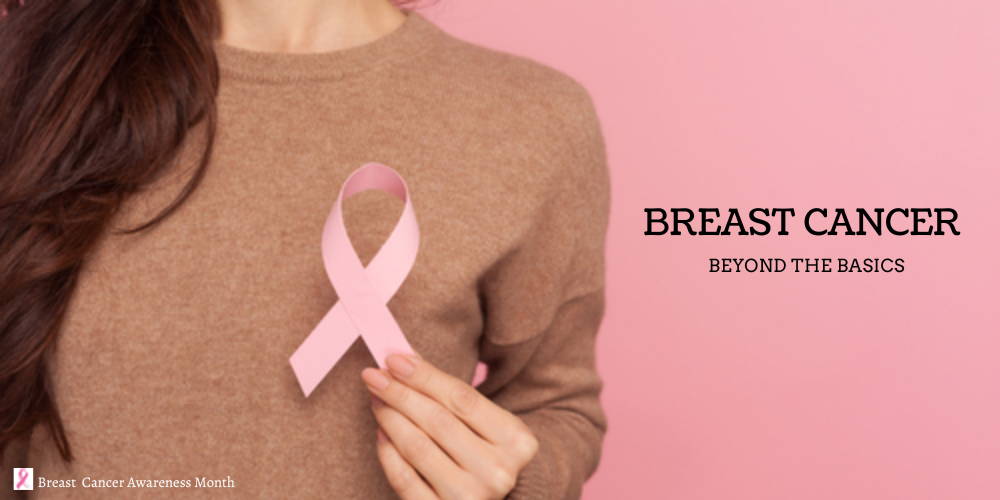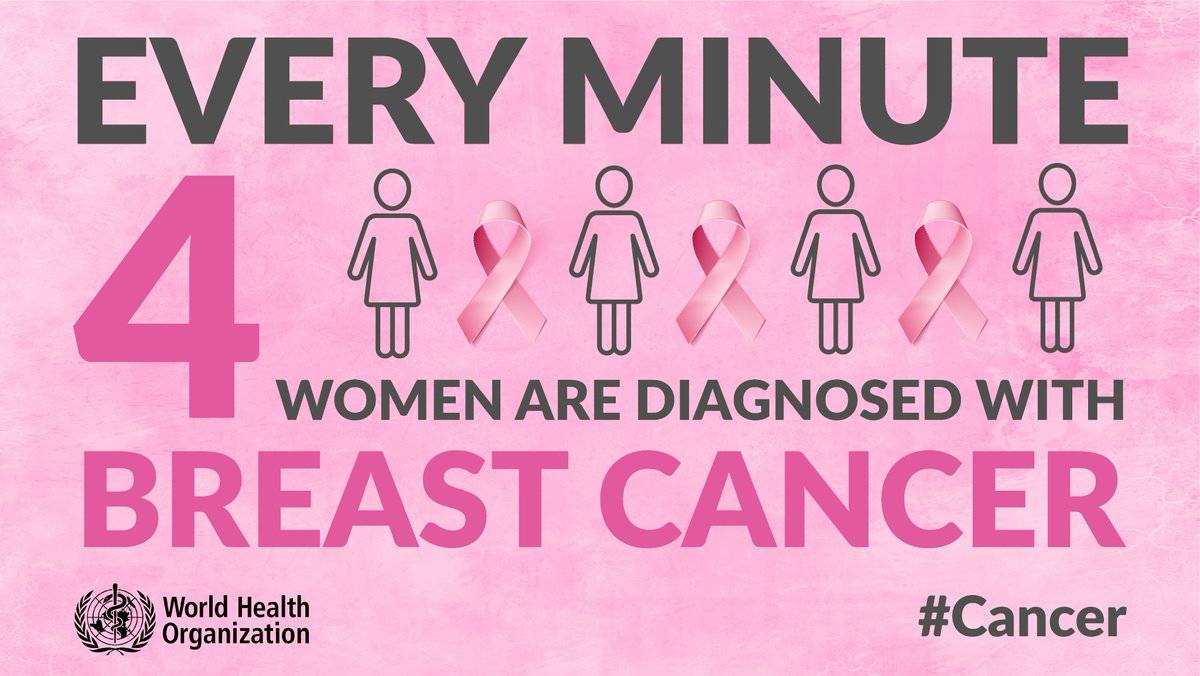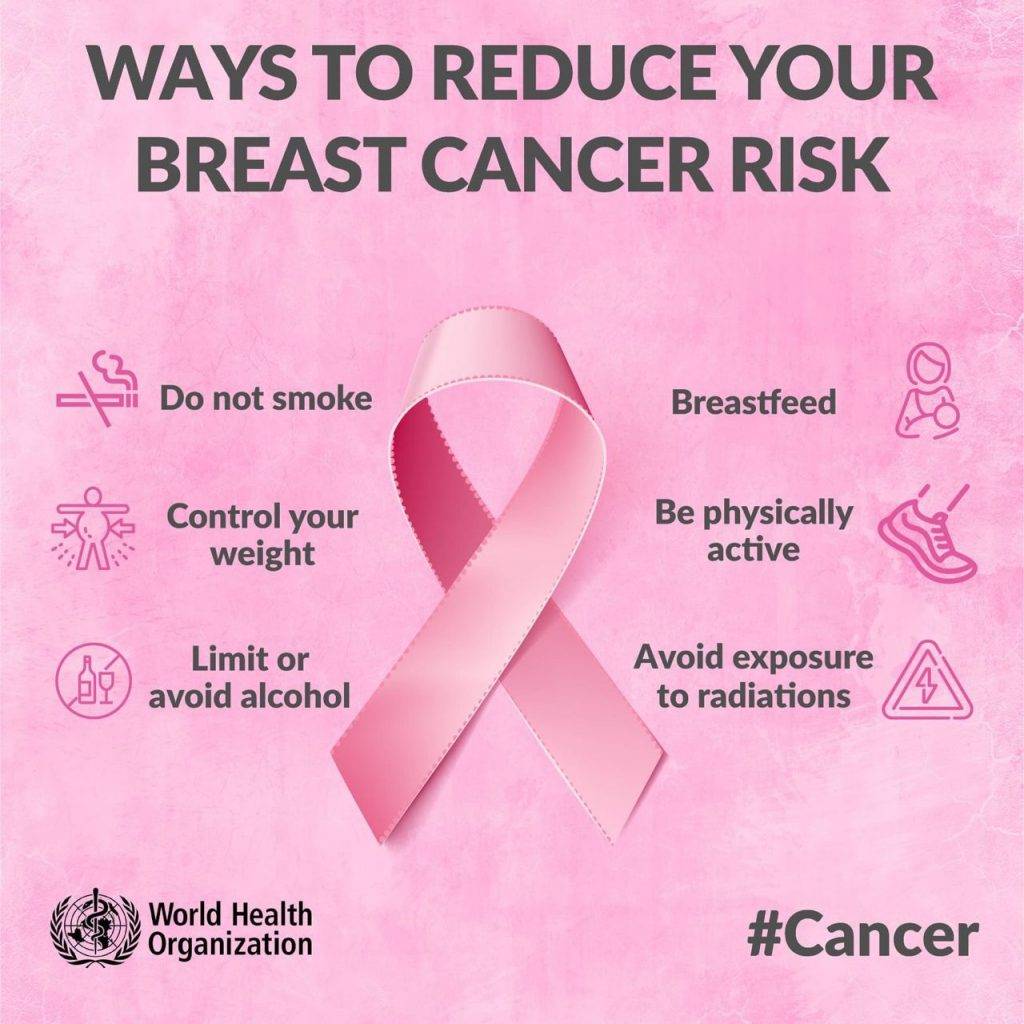
Breast cancer is the most common cancer in women worldwide. It is the second leading cause of cancer death after lung cancer in developed countries. 1.67 million new cases are diagnosed each year. In less developed regions of the world, it is the most frequent cause of death from cancer. The incidence of breast cancer increases with age, but no age is immune. It is however extremely rare before puberty.
What is breast cancer?
The breast consists of various tissues ranging from very fatty tissue to very dense tissue with a network of lobes within the tissue. Every lobe consists of tiny, tube-like structures called lobules which contain milk glands. Milk is carried from lobes to nipples through these tiny ducts that connects the glands, lobules and lobes. The nipple lies in the middle of the areola, which is the darker area around the nipple. The breast also has blood vessels which carry the blood and nourishes the cells. Body waste products are drained from the lymph system. The vessels of the lymph attach to the lymph nodes that help combat infection.
Breast cancer is cancer that forms in the cells of the breasts. Breast cancer is one of the most common cause of death in women. Breast cancer can occur in both men and women, but it is more common in women. Deaths from breast cancer are now at the lowest ever in 40 years. This is mainly due to the improvements in the treatment of breast cancer. The outlook is best in those who are diagnosed when the cancer is still small and has not spread. More breast cancers are also now being diagnosed and treated at an early stage. In general, the more advanced the cancer then the less chance that treatment will be curative.
Breast cancer occurs when healthy cells change and develop out of control, forming a mass called a tumor which can be malignant (can grow and spread to other parts of the body) or benign (can grow but will not spread). Breast cancer spreads when the cancer grows into other parts of the body, or when they move through the blood vessels or lymph vessels to other parts of the body leading to a condition called metastasis.
Breast cancer not only spreads to nearby lymph nodes but also spread to other areas of the body such as liver, bones, lungs, and brain which is called metastatic or stage IV breast cancer. After the initial treatment, if breast cancer returns, it may recur locally (regional lymph nodes like the lymph nodes under the arm) or may also recur elsewhere in the body, which is called a distant recurrence or metastatic recurrence. Now-a-days there have been emerging advances in the diagnosis and treatment of breast cancer through awareness and funding for research. Breast cancer survival rates have increased due to factors such as earlier detection, a customized treatment approach and a better understanding of the disease.
Causes
A woman’s breast after puberty is made up of connective tissue, fat, and thousands of lobules These tiny glands produce milk for breastfeeding which is carried to the nipple through tiny tubes, or ducts. Cancer causes an uncontrollable multiplication of the cells. This excessive growth of cells causes cancer as the tumor requires nutrients and energy causing the depletion of surrounding cells. Breast cancer typically starts in the inner lining of milk ducts or the lobules that supply milk. It can also spread to other parts of the body leading to metastatic breast cancer.

What are the symptoms of breast cancer?
The possible symptoms for breast cancer include:
Symptoms cannot be detected in early stages of the cancer, because the tumor is too small to be felt or identified. The abnormality can still be evident in screening tests such as mammogram.
- Lump or thickened area of the breast
- Discharge from either of the nipples
- Swelling in all or part of the breast
- Change to the size or shape of breast or nipple
- Skin irritation or dimpling on the skin of the breast
- Nipple retraction
- Breast or nipple pain
- Breast skin appears red and scaly
What causes breast cancer?
The precise causes of breast cancer are unclear but the main risk factors are known. Nevertheless, most women who are considered at high risk for breast cancer do not get it, while many do with no known risk factors. There are various causes for breast cancer including:
- Increasing Age
- history of breast cancer
- Inherited genes that cause cancer risk
- Exposure to radiation
- Being obese or overweight
- Postmenopausal hormone therapy
- Never been pregnant
When to see a doctor?
It is always advised to consult the specialist if a woman observes any of these above symptoms to prevent the risk of breast cancer.
How often should I be screened for breast cancer?
Having regular mammograms may not prevent breast cancer, but it may help to reduce the probability that it will go undetected. The American College of Physicians (ACP) makes the following general recommendations for women at average risk for breast cancer:
- Women at 40 to 49: An annual mammogram is not recommended for this age group but women should discuss their preferences with the doctors or cancer specialists
- Women at 50 to 74: A mammogram is recommended for every other year
- Women 75 and older: Mammograms are no longer recommended
In breast cancer screening, a woman who has no signs or symptoms for the disease undergoes a breast examination such as:
Breast examination: A physical examination of the breast by a doctor or other health professional
Mammography: Mammogram is a low dose x-ray examination which produces breast images. Mammography plays a key role in early detection of breast cancers as it can sometimes display breast changes before a patient or doctor can sense them. Evidence has shown that annual mammograms can lead to early detection of breast cancers when most curable and breast conservation therapies are available. A mammogram can also detect in situ ductal carcinoma (DCIS), abnormal cells that may grow into invasive cancer in the lining of a breast duct. Mammography is the only screening method for breast cancer proven to minimize disease deaths.
What are the benefits and risks of screening?
Every screening test has benefits and risks that is why it is important to discuss with your doctor before getting any screening test for breast cancer.
Benefits: The screening can help in identifying the disease at the early stage where it can be treatable.
Risks: Screening risks may include false positive test results (when a physician sees something that looks like cancer but it is not). This can result in undergoing more tests that may be expensive, invasive, time-consuming, and cause anxiety. Testing can also lead to overdiagnosis when doctors find a cancer that has not cause any symptoms or problems.
Am I at risk for getting breast cancer?
There are various risk factors that potentiate the spread of breast cancer. Some of them cannot be avoided like family history, whereas other lifestyle factors can be controlled. These include:

- Being obese/overweight: Women who become overweight or obese after menopause may also have a greater risk of developing breast cancer due to increased levels of estrogen and large intake of sugar
- Age: Increased age can elevate the risk of developing breast cancer. Most invasive breast cancers are found in women above 55 years of age
- Genetics: Women carrying certain mutations in the inherited genes BRCA1 and BRCA2 are more likely to develop breast cancer, ovarian cancer, or both. TP53 gene mutations also cause increased risk of breast cancer
- Hereditary/family history of breast cancer: Women with past medical history of breast cancer are more likely to get it again than those who don’t have any history of the disease. A woman who have certain types of non-cancerous breast lump such as atypical ductal hyperplasia or in situ lobular carcinoma can have increased risk to develop cancer later. Individuals with a history of breast, ovarian, fallopian tube or peritoneal cancer should undergo genetic testing to avoid the risk of recurrence
- Dense breasts: Dense breast tissue can be one of the major causes of breast cancer and it also makes mammograms hard to read
- Alcohol consumption: Women who consume alcohol at higher rate have greater risk of developing breast cancer than those who do not drink
- Early menstruation: Women who attain their puberty early (less than 10 years) have an increased risk for breast cancer
- Late pregnancy: Women who don’t have their first child until the age of 35 have an increased risk of breast cancer
- Hormone therapy: Women who have taken or are under the medication of postmenopausal estrogen and progesterone to reduce their signs of menopause symptoms have a higher risk of breast cancer
- Late menopause: Women who get their menopause until the age of 55 are more likely to develop breast cancer
- Never being pregnant: Women who were never pregnant or have never completed a pregnancy continue to develop breast cancer
What are the precautionary measures taken to prevent breast cancer?
Lifestyle changes in your daily life may help you to reduce risk for breast cancer. Try to follow the recommended precautionary measures in order to avoid the risk for breast cancer including:
- Ask your doctor about being screened for breast cancer examinations and tests such as clinical breast exams and mammograms, when to begin the scan for breast cancer
- Ensure that you and your doctor discuss to get awareness about the benefits and risks of screening. Together, you can decide the best possible breast cancer screening strategies for you
- Self-examine is very important precautionary measure. Women should choose to familiarize themselves with their breasts by occasionally inspecting them for breast awareness during a self-exam. If your breasts are experiencing a new change, any lumps or other odd symptoms, speak to your doctor immediately
- Limit the amount of alcohol to not more than one drink a day, if you choose to drink.
- Physical fitness is also important to avoid any risk for breast cancer. Aim for at least 30 minutes of exercise at least for 4 days in a week
- Try to limit the postmenopausal hormone therapy. Combination hormone therapy can potentiate the risk for breast cancer.
- Discuss the benefits and risks of the treatment with your doctor to avoid any complications
- Use the smallest possible dose of hormone therapy for the shortest period of time to reduce the risk of breast cancer

- Maintain a healthy body weight. If you fall under healthy body weight, then work out to maintain that weight. If you need to lose weight, ask your doctor about various health strategies to accomplish this. Reduce the number of calories you eat every day, and increase the amount of exercise gradually
- Maintain a healthy diet. Women eating a Mediterranean diet supplemented with extra virgin olive oil and mixed nuts may be at reduced risk of breast cancer. The Mediterranean diet mainly focuses on plant-based foods like whole grains, legumes, fruits and vegetables, and nuts. People who follow this diet choose healthy fats such olive oil over butter and fish rather than red meat
- If your doctor assesses your family history and determines that other factors, such as precancerous breast disease can increase your risk of breast cancer, you should discuss the options to reduce your risk such as:
- Chemoprevention: In certain women with high risk of the disease use of Estrogen-blocking medications such as selective estrogen receptor modulators and aromatase inhibitors reduce the risk of breast cancer
- Preventive surgery: Women who are at very high risk for breast cancer may opt to undergo surgical removal of healthy breasts (prophylactic mastectomy). They may also choose to remove their healthy ovaries ((prophylactic oophorectomy) to reduce the risk of both breast cancer and ovarian cancer

